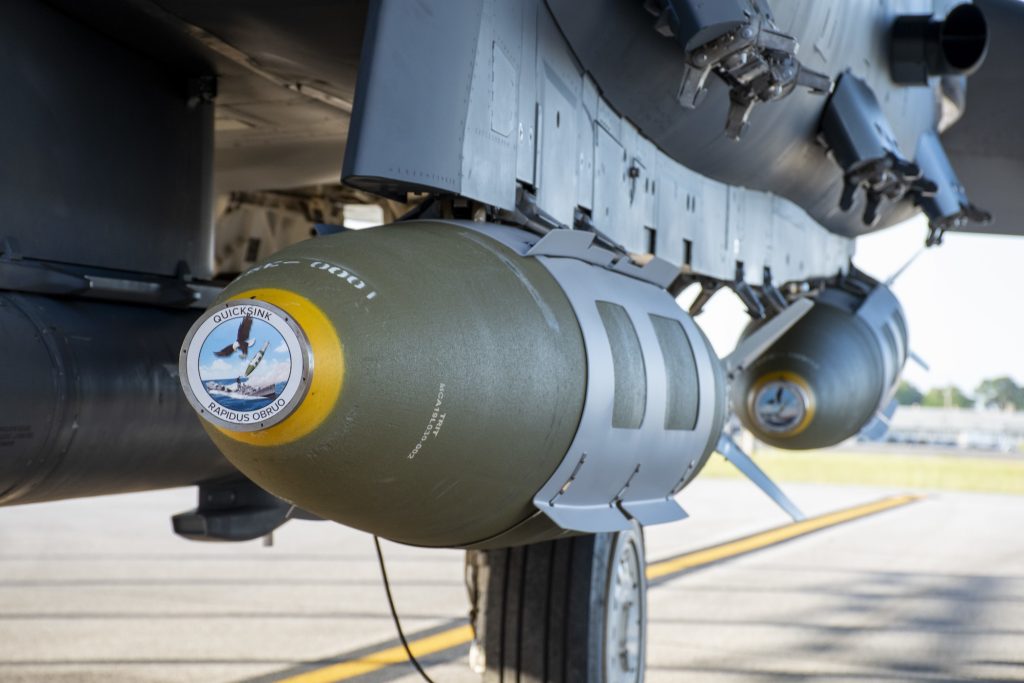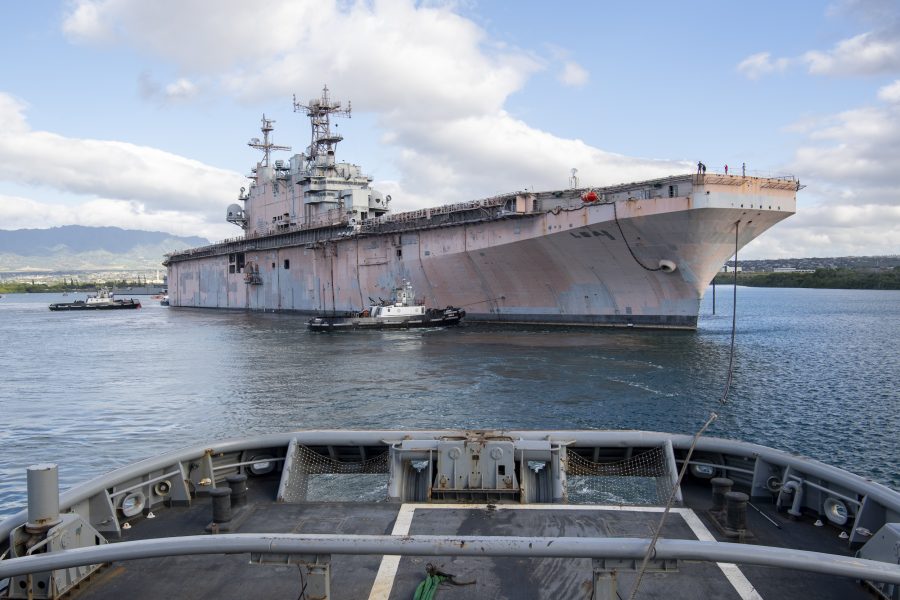The U.S. military conducted an unusual exercise recently during which a U.S. Air Force B-2 Spirit stealth bomber helped sink a decommissioned U.S. warship in the Pacific using relatively inexpensive GPS-guided bombs.
As part of the massive RIMPAC maritime and air exercise, the U.S. sunk two warships with live-fire weapons: the ex-USS Tarawa, an amphibious assault ship, and the ex-USS Dubuque, an amphibious transport dock, in what is known as a SINKEX.
SINKEXs are training exercises in which decommissioned naval vessels are used as targets. This year, the USS Tarawa was hit by the U.S. military’s top-shelf maritime strike weapon, the multimillion-dollar stealthy Long-Range Anti-Ship Missile (LRASM), which was fired from a U.S. Navy F/A-18F Super Hornet.
But the USAF also came to play, and in a novel way.
Along with Navy assets, the B-2 “proved a low-cost, air-delivered method for defeating surface vessels through a QUICKSINK demonstration,” the U.S. Third Fleet, which is responsible for U.S. Navy operations in the Pacific, said in a July 22 release.
“The B-2 was used to help sink the Tarawa,” a spokesperson for the Third Fleet added in an email to Air & Space Forces Magazine.
“This capability is an answer to an urgent need to quickly neutralize maritime threats over massive expanses of ocean around the world at minimal costs,” the release said.
After two decades of intensive bombing during the Global War on Terror, QUICKSINK and LRASM demonstrate just how much the Air Force’s focus has shifted despite the ongoing conflicts still raging in the Middle East, including some involving U.S. forces.
“This is a sign of the Air Force’s renewed focus on maritime strike, which it had walked away from after the Cold War ended,” Stacie Pettyjohn, director of the defense program at the Center for a New American Security, told Air & Space Forces Magazine.
QUICKSINK is a system now mated to JDAMs, the near-ubiquitous air-to-surface GPS guidance kit for bombs. It has additional guidance to turn those weapons into ship-killers, offering more value for money and giving commanders more options, the Navy and Air Force say.
“Torpedoes, such as the heavyweight MK-48, are still the primary method used to sink enemy ships,” the Air Force Research Laboratory (ARFL) says of QUICKSINK. “New methods explored through QUICKSINK may be able to achieve the same kind of anti-ship lethality with air-launched weapons, including modified 2,000-pound class precision-guided bombs.”

Pentagon and open-source wargames have shown precision munitions, especially LRASMs, would be expended quickly in a conflict with China, in perhaps a few days. Torpedos are also expensive and can only be deployed by a few Navy platforms. The new Joint Strike Missile (JSM) is on its way in the coming years, but that still leaves room for a wide variety of anti-ship weapons in between.
“Both standoff and penetrating maritime strikes are needed to create the volume that’s going to be required to deny the first attempt by the PLA Navy to invade a friend such as Taiwan or elsewhere in the South China Sea,” said Mark Gunzinger, director of future concepts and capability assessments at the Mitchell Institute for Aerospace Studies.
QUICKSINK capabilities are not brand new, with previous tests being conducted by fourth-generation F-15E Strike Eagle fighters in 2021 and 2022. The program is still a “technology demonstration,” according to AFRL, not a front-line weapon. Whatever the precise weapon, U.S. military leaders have noted that munitions stockpiles have been an easy place to save money. But Russia’s invasion of Ukraine, which has stressed Western and Russian defense industries to near their breaking point, along with the prospect of the U.S. being involved in a conflict to repel China from seizing the self-governing island of Taiwan, have shown just valuable munitions are.
“It would be impossible to fight and win against China from only long-range,” Pettyjohn said. “It is also hard to generate sufficient mass over a period of time with standoff strikes.”
“QUICKSINK would complement existing anti-ship missile procurements and provide a much lower-cost weapon that could be bought in large numbers,” she added. “It would, along with LRASM and JSM, provide the Air Force with a range of maritime strike options that can be launched from different ranges.”
A QUICKSINK munition could also be especially valuable in disrupting undefended enemy logistics vessels such as cargo ships and oilers, which often lack their own advanced air defense systems, Pettyjohn added.
The latest test occurred during RIMPAC, which is the world’s largest maritime exercise, with 25,000 personnel from 29 nations participating, bringing with them 40 surface ships, three submarines, more than 150 aircraft, and 14 national land forces exercise in and around the Hawaiian Islands, June 27 to Aug. 1, according to numbers from the Third Fleet.
With the U.S. military focused on a possible flight with China over Taiwan, the U.S. has been trying to ramp up LRASM production. The missile is a derivative of the JASSM long-range cruise missile, which is made on the same production line by Lockheed Martin. But with tight government budgets, even if production could be ramped up, LRASMs are still pricey. The missiles cost upwards of $3 million a copy, which make them cost-prohibitive to buy in massive numbers, Gunzinger and Pettyjohn said. The Air Force plans to buy 115 LRASMs next year and around 550 by end of the decade.
“The Air Force and the DOD simply can’t buy enough of them to meet requirements,” Gunzinger said.
Gunzinger, a former B-52 pilot who focused on assessing capabilities to counter anti-access and area-denial (A2/AD) threats in different civilian positions, said the Pentagon and the Air Force are rightfully looking at developing cheaper, short- and medium-range standoff weapons, as stealthy aircraft cannot fly completely unfettered in contested airspace.
“Having a portfolio of different maritime strike weapons that includes high, low, and medium options is ideally what is needed,” Pettyjohn added.
As for QUICKSINK, the system has been in the making for a long time. In 2004, Pacific Air Forces practiced employing JDAMs against the ex-USS Schenectady in an exercise known as Resultant Fury some 20 years ago, and U.S. Airmen have been targeting ships for over a century.
The ex-USS Dubuque and ex-USS Tarawa were sunk on July 11 and July 19, respectively, just shy of the anniversary of Army Air Service Brig. Gen. Billy Mitchell’s sinking of another decommissioned vessel, the captured German battleship Ostfriesland, on July 21, 1921—one of the most significant events in the evolution of airpower.
“The most effective—and efficient—way to kill ships is from the air,” said retired Lt. Gen. David A. Deptula, who was the two-star director of air and space operations for Pacific Air Forces during its 2004 Resultant Fury test and is now the dean of the Mitchell Institute for Aerospace Studies. “The Air Force has a history of maritime attack, and it should double down on that history with appropriate funding support from the Congress.”
